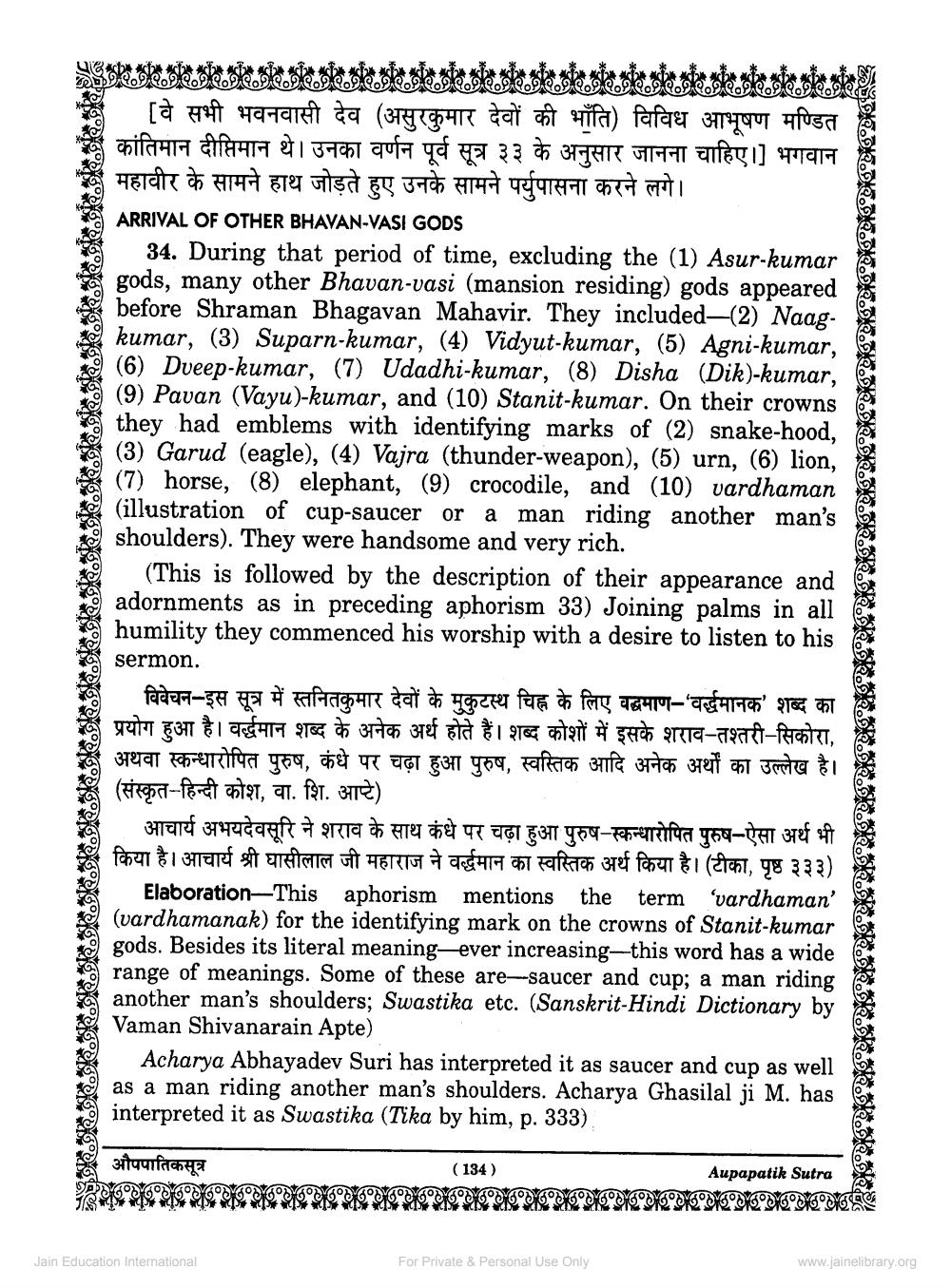________________
" [वे सभी भवनवासी देव (असुरकुमार देवों की भाँति) विविध आभूषण मण्डित " कांतिमान दीप्तिमान थे। उनका वर्णन पूर्व सूत्र ३३ के अनुसार जानना चाहिए।] भगवान " महावीर के सामने हाथ जोड़ते हुए उनके सामने पर्युपासना करने लगे। SHE ARRIVAL OF OTHER BHAVAN-VASI GODS
34. During that period of time, excluding the (1) Asur-kumar gods, many other Bhavan-vasi (mansion residing) gods appeared before Shraman Bhagavan Mahavir. They included—(2) Naag
kumar, (3) Suparn-kumar, (4) Vidyut-kumar, (5) Agni-kumar, 8 (6) Dveep-kumar, (7) Udadhi-kumar, (8) Disha (Dik)-kumar,
(9) Pavan (Vayu)-kumar, and (10) Stanit-kumar. On their crowns they had emblems with identifying marks of (2) snake-hood, (3) Garud (eagle), (4) Vajra (thunder-weapon), (5) urn, (6) lion, (7) horse, (8) elephant, (9) crocodile, and (10) vardhamand (illustration of cup-saucer or a man riding another man's shoulders). They were handsome and very rich.
(This is followed by the description of their appearance and adornments as in preceding aphorism 33) Joining palms in all humility they commenced his worship with a desire to listen to his sermon.
विवेचन-इस सूत्र में स्तनितकुमार देवों के मुकुटस्थ चिह्न के लिए बद्धमाण-'वर्द्धमानक' शब्द का प्रयोग हुआ है। वर्द्धमान शब्द के अनेक अर्थ होते हैं। शब्द कोशों में इसके शराव-तश्तरी-सिकोरा, अथवा स्कन्धारोपित पुरुष, कंधे पर चढ़ा हुआ पुरुष, स्वस्तिक आदि अनेक अर्थों का उल्लेख है।
(संस्कृत-हिन्दी कोश, वा. शि. आप्टे) I आचार्य अभयदेवसूरि ने शराव के साथ कंधे पर चढ़ा हुआ पुरुष-स्कन्धारोपित पुरुष-ऐसा अर्थ भी किया है। आचार्य श्री घासीलाल जी महाराज ने वर्द्धमान का स्वस्तिक अर्थ किया है। (टीका, पृष्ठ ३३३)
Elaboration-This aphorism mentions the term 'vardhaman' 19 (vardhamanak) for the identifying mark on the crowns of Stanit-kumar
gods. Besides its literal meaning-ever increasing--this word has a wide range of meanings. Some of these are-saucer and cup; a man riding another man's shoulders; Swastika etc. (Sanskrit-Hindi Dictionary by Vaman Shivanarain Apte)
Acharya Abhayadev Suri has interpreted it as saucer and cup as well as a man riding another man's shoulders. Acharya Ghasilal ji M. has interpreted it as Swastika (Tika by him, p. 333),
औपपातिकसूत्र
(134)
Aupapatik Sutra
Jain Education International
For Private & Personal Use Only
www.jainelibrary.org




